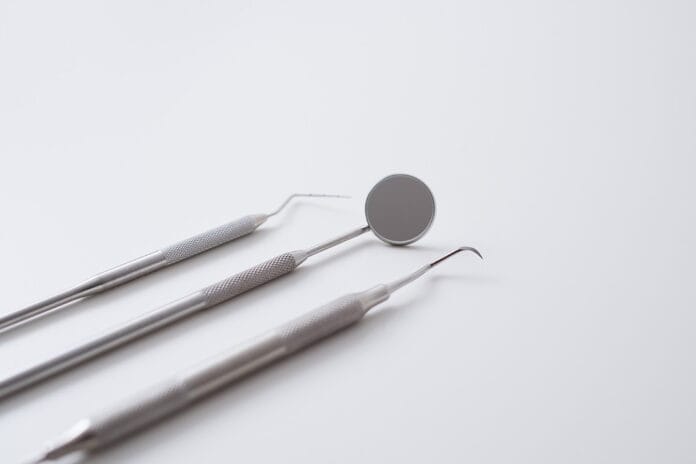I hope I am not the only dental hygienist who has ever found herself trying to scale tenacious (or even not so tenacious) calculus with instruments that feel like dull kitchen spoons that arrived in 1620 on the Mayflower. It can be so defeating and frustrating to try and do your dental hygiene job with inadequate instruments.
I compare it to trying to tweeze your eyebrows with a clothespin or shaving your legs with a butter knife. It just ain’t happening! I cannot remember the amount of time that was set aside to teach me about sharpening instruments in dental hygiene school, but I can say it was not nearly enough.
We all realize the importance of sharpening, which reduces stress and encourages better ergonomics for the hygienist. It can also lead to less trauma for the patient, better and improved patient and operator comfort, and quicker appointment times. The hygienist has better control of the instruments and is more precise in the removal of calculus. The use of sharp instruments lessens the fatigue of hands, shoulders, and wrists of the clinician, plus sharpening extends the life of the instrument.
Taking the Time for Sharpening
It sounds like a win/win for patients and hygienists, but do we have or take the time to sharpen our “tools of the trade” adequately, or do we even know how to accomplish this? Some offices will allow the hygienist to block off an hour for the purpose of trying to sharpen instruments. Most clinicians, in my opinion, do not feel comfortable sharpening their instruments. Hygiene instruments are very precise with toes or tips and cutting surfaces, and we don’t want to mess them up and cause beveling.
In my experience, most doctors do not like to see hygienists sharpening instruments either. In their eyes, it is not productive. No patient equals no production. Truthfully, in a busy dental practice, if you do have a cancellation or a no-show, that time is usually spent catching up on sterilization, clinical notes, restocking your operatory, and helping with the daily aspects of keeping the office running smoothly. We just don’t have a lot of time left for sharpening, even though it is critical to our success.
So, what do we do? There are a few options available for keeping the scalers and curettes at their best, and you will have to decide with your doctor which one will work the best for your particular office.
Sharpening Options
If money is no object, you can simply dispose of the dull instruments and order new ones. Hygiene instruments typically have a lifespan of nine to 18 months depending on factors such as, but not limited to, the number of setups you have, the number of patients you see, the difficulty of your patients, etc.
Even so, I find brand new instruments are sometimes too fat to access the areas I need them to, and I like a sharpened smaller version. In this case, sharpen-free instruments arrive from the manufacturer a touch thinner than the stainless steel counterparts that do need to be sharpened. I have never had the luxury of working in an office that allowed this, but maybe a unicorn doctor out there does this. You let me know if so!
Sharpening services ‒ Some manufacturers offer sharpening services. I have used this option before, and it worked quite well. You are on a paid plan (you pick the plan in regards to how many instruments you want sharpened for free, if you want the ones that can’t be sharpened returned, and cost) for a determined amount of time and send in your dull instruments to be sharpened. If the manufacturer deems they cannot be brought back to the optimum shape and sharpness, you have the option of replacing them.
This is such an easy process, but it does come with a related cost. You pay for a plan, and then after a certain number of “free” replacements, you must pay for the remainder that may need to be replaced if you choose that. Each manufacturer has various rules that apply to their plan.
Automated sharpening systems ‒ These devices will also help the clinician with the DIY method. Choosing these methods helps to tackle the task in a quicker amount of time. Some are battery operated and aid in the angulation of the blade by use of instrument guide channels and a backstop. The hygienist places the instrument in the machine correctly, and the machine automatically sharpens the instrument. Easy peasy!
Another style of automated sharpener achieves its results by using a dry ceramic stone with a dial used for proper placement. The hygienists aligns the handle parallel to the proper lines on the dial and then pulls the instrument along the stone, thus resulting in a sharpened edge. This has removable parts that are autoclavable, making it ideal for chairside sharpening.
Another style of automated sharpener is a fixed stone, motorized system that boasts preserved angles of the original instruments and consistent, precise angles with very little help from us, the clinician. The hygienist is responsible for securing the dull instrument into the device and letting it do the rest. Look, Ma, no hands!
Sharpening guides/stones ‒ There are also sharpening guides that are placed on a stone, which help keep the edge from beveling during sharpening. These are autoclavable.
The last option is the use of a flat stone, usually white, gray, or red, and manipulating the instrument or stone by hand to sharpen. Clinicians can always take a course to update themselves on proper technique, if needed, as well as watch videos via the internet to help with angulation and proper techniques of hand sharpening. The warning associated with this option is that it can lead to error and reconfigured instruments if done poorly. I have seen and possibly am to blame for curettes that have been sharpened to sickles more than once in my career.
Most of us have our tried-and-true favorite instruments and are very picky (see what I did there) about sharing them or using something different. Keeping those favorites sharp will make your challenges of removing calculus and completing nonsurgical periodontal therapy much easier. I urge you to have a discussion about sharpening with your doctor and hygiene team and decide what will be best to implement within your own team for the health of the clinician, the budget for the hygiene department, and the comfort of the patient.











